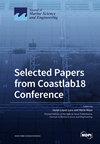基于双级空间注意力和深度聚核网络的合成孔径雷达图像中的船舶探测
IF 2.8
3区 地球科学
Q1 ENGINEERING, MARINE
引用次数: 0
摘要
合成孔径雷达(SAR)是一种广泛应用于船舶探测领域的技术。然而,由于船舶密度高、前景-背景不平衡以及目标大小不一,实现轻量级和高精度的多尺度船舶目标检测仍然是一项重大挑战。针对这些挑战,本研究提出了一种多尺度 SAR 船舶检测方法 YOLO-MSD。首先,我们提出了一种深度多核骨干网络(DPK-Net),利用优化卷积(OC)模块减少数据冗余,并利用多核(PK)模块提高特征提取能力和规模适应性。其次,我们设计了一个双层空间注意力模块(BSAM),它由双层路由注意力(BRA)和空间注意力模块组成。BRA 首先用于捕捉全局信息。然后,空间注意力模块用于提高网络定位目标和捕捉高质量详细信息的能力。最后,我们采用了一个强大的损耗函数(P-IoU),它可以根据船只大小进行自适应调整,有效地引导锚箱实现更快、更准确的检测。使用 HRSID 和 SSDD 作为实验数据集,在模型规模为 12.3 M 时,mAP 分别达到 90.2% 和 98.8%,比基线分别高出 5.9% 和 6.2%。本文章由计算机程序翻译,如有差异,请以英文原文为准。
Ship Detection in Synthetic Aperture Radar Images Based on BiLevel Spatial Attention and Deep Poly Kernel Network
Synthetic aperture radar (SAR) is a technique widely used in the field of ship detection. However, due to the high ship density, fore-ground-background imbalance, and varying target sizes, achieving lightweight and high-precision multiscale ship object detection remains a significant challenge. In response to these challenges, this research presents YOLO-MSD, a multiscale SAR ship detection method. Firstly, we propose a Deep Poly Kernel Backbone Network (DPK-Net) that utilizes the Optimized Convolution (OC) Module to reduce data redundancy and the Poly Kernel (PK) Module to improve the feature extraction capability and scale adaptability. Secondly, we design a BiLevel Spatial Attention Module (BSAM), which consists of the BiLevel Routing Attention (BRA) and the Spatial Attention Module. The BRA is first utilized to capture global information. Then, the Spatial Attention Module is used to improve the network’s ability to localize the target and capture high-quality detailed information. Finally, we adopt a Powerful-IoU (P-IoU) loss function, which can adjust to the ship size adaptively, effectively guiding the anchor box to achieve faster and more accurate detection. Using HRSID and SSDD as experimental datasets, mAP of 90.2% and 98.8% are achieved, respectively, outperforming the baseline by 5.9% and 6.2% with a model size of 12.3 M. Furthermore, the network exhibits excellent performance across various ship scales.
求助全文
通过发布文献求助,成功后即可免费获取论文全文。
去求助
来源期刊

Journal of Marine Science and Engineering
Engineering-Ocean Engineering
CiteScore
4.40
自引率
20.70%
发文量
1640
审稿时长
18.09 days
期刊介绍:
Journal of Marine Science and Engineering (JMSE; ISSN 2077-1312) is an international, peer-reviewed open access journal which provides an advanced forum for studies related to marine science and engineering. It publishes reviews, research papers and communications. Our aim is to encourage scientists to publish their experimental and theoretical results in as much detail as possible. There is no restriction on the length of the papers. The full experimental details must be provided so that the results can be reproduced. Electronic files and software regarding the full details of the calculation or experimental procedure, if unable to be published in a normal way, can be deposited as supplementary electronic material.
 求助内容:
求助内容: 应助结果提醒方式:
应助结果提醒方式:


